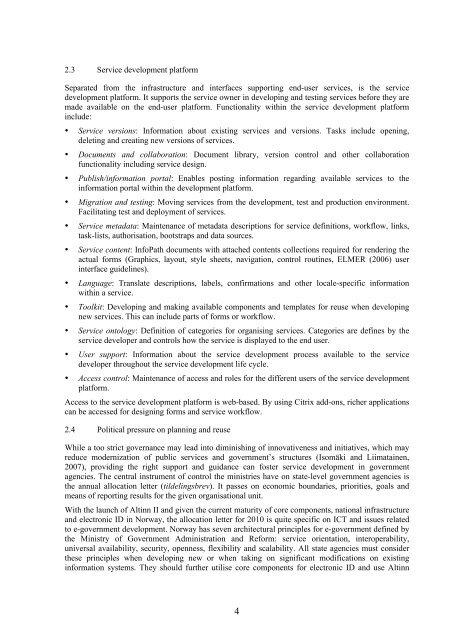Multi-channel provisioning of public services - Department of ...
Multi-channel provisioning of public services - Department of ...
Multi-channel provisioning of public services - Department of ...
You also want an ePaper? Increase the reach of your titles
YUMPU automatically turns print PDFs into web optimized ePapers that Google loves.
2.3 Service development platform<br />
Separated from the infrastructure and interfaces supporting end-user <strong>services</strong>, is the service<br />
development platform. It supports the service owner in developing and testing <strong>services</strong> before they are<br />
made available on the end-user platform. Functionality within the service development platform<br />
include:<br />
• Service versions: Information about existing <strong>services</strong> and versions. Tasks include opening,<br />
deleting and creating new versions <strong>of</strong> <strong>services</strong>.<br />
• Documents and collaboration: Document library, version control and other collaboration<br />
functionality including service design.<br />
• Publish/information portal: Enables posting information regarding available <strong>services</strong> to the<br />
information portal within the development platform.<br />
• Migration and testing: Moving <strong>services</strong> from the development, test and production environment.<br />
Facilitating test and deployment <strong>of</strong> <strong>services</strong>.<br />
• Service metadata: Maintenance <strong>of</strong> metadata descriptions for service definitions, workflow, links,<br />
task-lists, authorisation, bootstraps and data sources.<br />
• Service content: InfoPath documents with attached contents collections required for rendering the<br />
actual forms (Graphics, layout, style sheets, navigation, control routines, ELMER (2006) user<br />
interface guidelines).<br />
• Language: Translate descriptions, labels, confirmations and other locale-specific information<br />
within a service.<br />
• Toolkit: Developing and making available components and templates for reuse when developing<br />
new <strong>services</strong>. This can include parts <strong>of</strong> forms or workflow.<br />
• Service ontology: Definition <strong>of</strong> categories for organising <strong>services</strong>. Categories are defines by the<br />
service developer and controls how the service is displayed to the end user.<br />
• User support: Information about the service development process available to the service<br />
developer throughout the service development life cycle.<br />
• Access control: Maintenance <strong>of</strong> access and roles for the different users <strong>of</strong> the service development<br />
platform.<br />
Access to the service development platform is web-based. By using Citrix add-ons, richer applications<br />
can be accessed for designing forms and service workflow.<br />
2.4 Political pressure on planning and reuse<br />
While a too strict governance may lead into diminishing <strong>of</strong> innovativeness and initiatives, which may<br />
reduce modernization <strong>of</strong> <strong>public</strong> <strong>services</strong> and government’s structures (Isomäki and Liimatainen,<br />
2007), providing the right support and guidance can foster service development in government<br />
agencies. The central instrument <strong>of</strong> control the ministries have on state-level government agencies is<br />
the annual allocation letter (tildelingsbrev). It passes on economic boundaries, priorities, goals and<br />
means <strong>of</strong> reporting results for the given organisational unit.<br />
With the launch <strong>of</strong> Altinn II and given the current maturity <strong>of</strong> core components, national infrastructure<br />
and electronic ID in Norway, the allocation letter for 2010 is quite specific on ICT and issues related<br />
to e-government development. Norway has seven architectural principles for e-government defined by<br />
the Ministry <strong>of</strong> Government Administration and Reform: service orientation, interoperability,<br />
universal availability, security, openness, flexibility and scalability. All state agencies must consider<br />
these principles when developing new or when taking on significant modifications on existing<br />
information systems. They should further utilise core components for electronic ID and use Altinn<br />
4
















